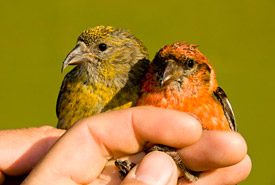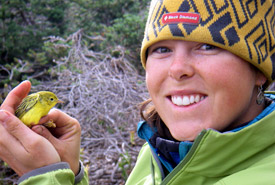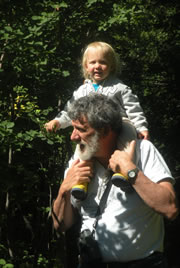Tatlayoko forever! The Tatlayoko Lake Bird Observatory opens for a ninth season

White-winged crossbills, Tatlayoko Lake Bird Observatory, British Columbia (Photo by Steve Ogle)
Although trained as a vegetation ecologist, I have been interested in birds and birdwatching for many years. To my delight, in 2006 I was asked to design a monitoring program for migratory birds at the Nature Conservancy of Canada’s (NCC's) Tatlayoko Lake Ranch, in BC’s West Chilcotin region.
The intent of the Tatlayoko Lake Bird Observatory (TLBO) is to monitor changes in bird populations over the years. And by “years,” experts say we would need at least 10 years of data. Today I am excited to share that we are about to launch our ninth season at the Tatlayoko Lake Bird Observatory. So we are closing in on the minimum number of years that will ensure this project is making a genuine contribution to our knowledge and understanding about migratory birds.
Over the past nine years I have had the fun of coming up with funding, hiring banders, helping write the protocol for the station and, best of all, spending time on-site helping out with the work and ensuring high quality results. Imagine having to spend a week each summer in such a beautiful place, birdwatching for hours every day, all the while calling it “work”!
One of the side benefits is watching other volunteers and visitors of all ages experience the joy of handling and releasing a banded bird. Volunteers are taught accurate data entry, bird extraction from nets, bird identification, aging and sexing and related bird biology. The only requirement of volunteers is a keen interest in birds — we see everyone from those with little expertise to experienced birders.

Jasmin Dobson holds a warbler at the Tatlayoko Lake Bird Observatory (Photo by NCC)
The observatory operates for the fall migration season — August and September — during which time volunteers catch and band birds as they move through the Tatlayoko Valley on their way south. Bird banding involves placing a metal band with a unique serial number on a bird’s leg, so that the bird can be individually identified when it is found again. The banding activity, which requires federal permits, is overseen by the North American Bird Banding Program for migratory birds, which involves Canada, the United States and Mexico.
Bird migration monitoring provides baseline information on avian populations, which is crucial for bird conservation. The Canadian Migration Monitoring Network, of which TLBO is a full member, defines migration monitoring as any standardized program of sampling migrants, by capture or observation, which is repeated daily and annually and has the capacity to contribute scientifically meaningful data that further the understanding of bird migration ecology in Canada. It is generally accepted that at least 10 years of monitoring data is required to start analyzing trends in numbers and species, so NCC hopes to continue this project in perpetuity.
The information being documented at TLBO, and at all monitoring stations around the world, is fundamental to species conservation. This data allows scarce resources are to be allocated wisely and for sound reasons.
The Nature Conservancy of Canada employs two professional banders to implement the monitoring program at TLBO for the two-month banding season. For about 60 days, they spend six hours each day monitoring birds, starting at dawn each morning. Conservation Volunteers come from all across Canada and as far away as Europe to join our banders for a week at time to assist around the station and have an unparalleled experience interacting with the natural world.
Even if you can’t make out to remote Tatlayoko — getting there is truly an adventure in its own right! — you can follow the escapades at TLBO via the daily blog: TatlayokoBirds. The banders share the highlights from their day, including pictures of the birds and other wildlife, and quizzes to test your birding mettle.
The first blog for 2014 will be posted August 3.


